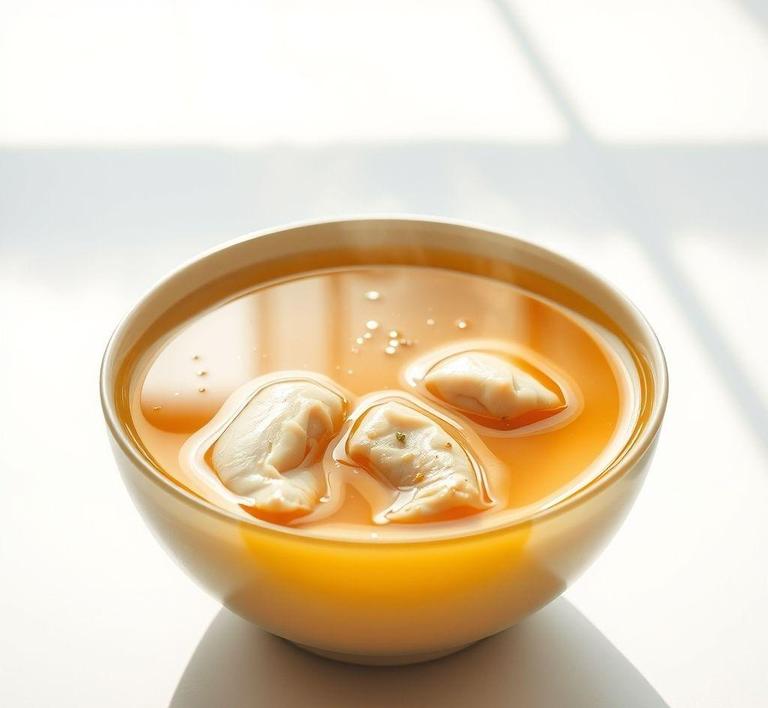Refreezing chicken broth can be a bit of a head-scratcher for many, especially when you’re not sure if it’s safe or how to go about it. We all know that broths can add so much flavor to our dishes, but what do you do when you have leftovers or you’ve made too much? The good news is, yes, you can refreeze chicken broth, but there are some important steps to follow to make sure it stays safe and delicious. Whether you’re looking to store extra broth for future soups or stews, or just trying to avoid waste, understanding the best methods for refreezing chicken broth will save you time, money, and a lot of frustration down the line. Let’s dive into everything you need to know!
Can You Refreeze Chicken Broth?

Chicken broth, a savory liquid gold packed with rich flavors and nutrients, is a staple in many kitchens. But what happens when you have leftover broth that you’ve already frozen once? Is it safe to refreeze chicken broth? The short answer is yes, but with some caveats.
Refreezing chicken broth is possible, but you should approach it with caution to ensure that both the quality and safety of the broth are maintained. The process of freezing and thawing can have some unintended effects on the texture and taste, but if done correctly, the broth can remain safe to eat and useful for cooking.
How To Refreeze Chicken Broth?
Refreezing chicken broth involves a few key steps to help maintain its integrity and prevent bacterial growth, which can lead to foodborne illnesses. Here’s how you can safely refreeze chicken broth:
-
Thawing Carefully:
The first step is to properly thaw the broth if it has been frozen previously. The safest way to thaw chicken broth is in the refrigerator over 24 hours. This slow thawing process reduces the risk of bacterial growth. Avoid leaving broth to thaw at room temperature or in warm water, as this can cause it to enter the danger zone (between 40°F and 140°F), which promotes bacteria growth.
-
Inspect Before Refreezing:
Before deciding to refreeze, give the broth a thorough check. Look for any signs of spoilage, such as an off smell or discoloration. If there are any indications that the broth has gone bad, it should be discarded immediately. If it smells fine and looks the way it did when you first froze it, then it’s good to go.
-
Portioning the Broth:
If you plan to refreeze, consider portioning out the broth into smaller containers or ice cube trays. This way, you only need to defrost the amount you need rather than thawing and refreezing the entire batch, which can degrade the quality. Freezing broth in smaller portions also speeds up the thawing process and reduces the risk of bacterial contamination.
-
Use a Freezer-Friendly Container:
The container you use for refreezing matters. Opt for airtight, freezer-safe containers or freezer bags that minimize air exposure, as this can cause freezer burn. Be sure to leave some space at the top of the container because liquids expand when frozen.
-
Label and Date:
Always label the containers with the date the broth was initially frozen and the date it was refrozen. This helps you track its age and ensures you use the oldest batch first, adhering to the ‘first in, first out’ principle to prevent waste.
-
Freeze Quickly:
Once your broth is properly prepared for freezing, place it in the freezer as quickly as possible. The quicker it freezes, the better it will retain its flavor and nutritional value. Spread the containers out in the freezer so the broth freezes evenly and faster.
Quality Impact
While it’s safe to refreeze chicken broth, doing so does come with some quality trade-offs. The biggest impact is on the flavor and texture.
-
Flavor Deterioration:
Every time chicken broth is frozen and thawed, it loses some of its original flavors. This is because freezing can cause some of the aromatic compounds in the broth to break down. Refreezing can make the broth taste a bit blander or slightly less fresh compared to the first freeze. If you notice a significant loss of flavor, you can remedy this by adding herbs, spices, or salt after thawing and before use to revitalize the taste.
-
Changes in Texture:
Another downside of refreezing chicken broth is the potential change in texture. Broth that is frozen and then refrozen may develop a slightly grainy or watery texture. This happens because freezing causes the water in the broth to expand and break apart the proteins and fat. When thawed again, these components may not re-integrate as smoothly, leading to a less cohesive liquid. If your broth appears separated after thawing, it can usually be fixed by reheating it on the stove and whisking or stirring it to combine the elements once more.
-
Risk of Nutrient Loss:
Repeated freezing and thawing can also affect the nutrient content of the broth. While most of the vitamins and minerals are stable in frozen broth, some delicate nutrients may degrade slightly with each freeze-thaw cycle, reducing the overall nutritional value.
-
Freezer Burn:
If the broth is not stored properly, refreezing can lead to freezer burn. This occurs when air gets into the container, causing dehydration on the surface of the broth. Freezer-burned broth may have an off taste and lack moisture, making it less appetizing. Proper sealing of containers and minimizing air exposure can reduce this risk.
Is It Safe To Refreeze Chicken Broth?
When it comes to food storage, especially liquids like chicken broth, the question of refreezing can stir up some uncertainty. The short answer is yes, you can refreeze chicken broth – but the process needs to be approached with caution.
Broth, being a liquid, is prone to changes in texture and quality when frozen, and these changes can sometimes become more pronounced with refreezing. The freezing process itself causes water in the broth to form ice crystals, which can damage the delicate structure of the liquid and the other ingredients (like vegetables, spices, and fats). When thawed, the broth might become slightly watery or lose some of its original flavor. Refreezing it after it has thawed can compound these changes.
However, the key concern with refreezing chicken broth revolves not just around its texture or taste, but also its safety. As with any food, improper handling during freezing, thawing, and refreezing could introduce harmful bacteria. Therefore, if you’re considering refreezing chicken broth, there are some important guidelines and precautions to follow.
The first rule is to ensure that the chicken broth was initially frozen while still fresh. Refreezing broth that’s been stored at room temperature for too long (more than two hours) is risky, as bacteria have had the opportunity to grow and multiply, making it unsafe for consumption. If it was properly chilled and frozen, however, it’s generally safe to refreeze as long as it has been handled correctly during each step of the process.
Signs That Chicken Broth Should Not Be Refrozen
Not all chicken broths are candidates for refreezing. Here are some telltale signs that your broth should be tossed rather than refrozen:
- Off Smell or Odor: If the chicken broth develops a sour, rancid, or off smell after being thawed, this indicates spoilage. Freezing slows down but doesn’t completely stop bacterial growth. If the broth has been sitting out too long before freezing or during thawing, it can lead to bacteria growth, which could make it unsafe to eat.
- Changes in Color or Texture: A drastic change in the broth’s color – for instance, if it becomes cloudy or overly greasy – can be a sign that it’s breaking down. While slight color changes from freezing are normal, drastic shifts in appearance, particularly after thawing, suggest that the broth is no longer at its best.
- Visible Mold or Foul Growth: Any visible mold growth is a clear sign that the broth has spoiled. Mold can form on the surface of liquids after they’ve been exposed to air or not stored properly, and it’s a definite red flag that the broth should be discarded.
- Excessive Separation: Chicken broth naturally separates into its fat and water components during freezing, but if the separation is extreme or if the water has become overly diluted, this is an indicator that the quality has declined. While you can stir it back together after thawing, significant changes in consistency can affect both the flavor and texture.
- Excessive Ice Crystals: While some ice crystals are normal during freezing, an unusual buildup of ice in your container might indicate that the broth wasn’t frozen quickly enough or wasn’t stored properly. This could compromise the broth’s texture and flavor after refreezing.
Common Refreezing Mistakes
Refreezing chicken broth seems straightforward enough, but there are several mistakes people commonly make that can impact both the quality and safety of the broth.
- Refreezing After Extended Thawing Time: If you allow your broth to thaw on the counter or in the fridge for too long, bacteria can begin to multiply, making it unsafe to refreeze. Chicken broth should be thawed in the refrigerator and never at room temperature.
- Not Portioning Properly: Refreezing large quantities of broth in one go can lead to thawing and refreezing more broth than you need. It’s better to divide your chicken broth into smaller portions before freezing so that you can thaw only what you’ll use. This minimizes the chances of refreezing the entire batch multiple times.
- Not Using Airtight Containers: When freezing or refreezing any food, including chicken broth, air exposure can lead to freezer burn and a decline in flavor. Always store your chicken broth in airtight containers or freezer bags designed for long-term storage. Additionally, make sure to leave some headspace in the container to allow for expansion as the broth freezes.
- Freezing Broth with Fat: Chicken broth often contains fat, which can become grainy or greasy when frozen and refrozen. While freezing fat itself isn’t necessarily harmful, it can affect the texture and mouthfeel of the broth after thawing. If you plan to refreeze, consider separating the fat and freezing it separately for better results.
- Thawing Incorrectly: The safest way to thaw chicken broth is in the refrigerator. If you use the microwave or let it thaw on the counter, you risk uneven heating, which can foster bacterial growth. Always defrost your broth gradually and evenly, preferably in a covered container, to maintain its quality.
Tips And Tricks
To ensure that your chicken broth stays safe and delicious after refreezing, follow these helpful tips and tricks:
- Freeze Quickly and Properly: When freezing chicken broth for the first time, try to freeze it in shallow, flat containers or freezer bags. This will allow it to freeze quickly, preserving the texture and preventing large ice crystals from forming.
- Cool Before Freezing: Never freeze hot broth straight from the stove. Allow it to cool down to room temperature before transferring it into containers for freezing. Rapidly cooling it in an ice bath can help speed up the process, preventing bacteria growth and helping to preserve the broth’s quality.
- Label and Date Your Broth: Keep track of how long your broth has been frozen. Generally, frozen chicken broth will last for 2 to 3 months, but it’s always a good idea to label containers with the date of freezing so you know when it’s time to use it up or throw it out.
- Use Ice Cube Trays for Small Portions: If you don’t want to refreeze a whole batch of broth, consider freezing smaller portions using an ice cube tray. These small portions are perfect for adding flavor to dishes and can be thawed quickly without the need for refreezing.
- Consider Straining the Broth: If your broth has been refrozen with solid pieces like chicken bits, herbs, or vegetables, consider straining them out after thawing before refreezing the liquid. This can help maintain a smoother texture and avoid unpleasant texture changes after thawing.
Conclusion
Refreezing chicken broth isn’t inherently dangerous, but it requires careful handling to maintain both safety and quality. The most important factors to consider are how the broth was handled initially (e.g., was it frozen while still fresh?), the conditions under which it was thawed, and how you manage the refreezing process itself. Avoid common mistakes like leaving broth out at room temperature for too long, not portioning it properly, or failing to store it in airtight containers.
By following proper freezing, thawing, and refreezing techniques, you can enjoy the convenience of having homemade chicken broth on hand without sacrificing its taste or safety. And while the texture might change slightly with refreezing, your broth can still be a flavorful and practical addition to your meals. So next time you find yourself wondering whether to refreeze chicken broth, as long as you adhere to the tips and signs mentioned above, you can do so confidently and without worry.


